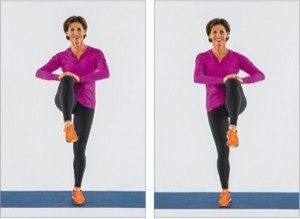Should I stretch before or after I exercise?
DEAR DOCTOR :
I’ve been running for years and have always stretched before my morning run. Now I hear that I shouldn’t stretch first. Why not?
DEAR READER:
You should stretch before your run — but perhaps not the types of stretches you’ve been doing.
Static stretches are what most people have traditionally done, both before and after exercise. Static stretches involve adopting and holding a position that stretches a muscle or group of muscles. For example, if you stand up straight and hinge forward at the hips, then hold the position with your arms hanging down, that’s an example of a static stretch. The purpose of static stretching is to encourage muscles to relax, which then allows them to be stretched a little longer. Static stretching promotes flexibility.
However, experts now believe that static stretching before exercising does not improve athletic performance. Indeed, it can actually undercut strength and power, possibly by affecting the ability of the muscles to store and swiftly release energy.
Exercises that require explosive muscular activity — like sprinting, or dunking a basketball — seem to be compromised by static stretches before exercise. So, generally speaking, it’s best to do static stretches after exercise or at a separate time entirely.
The best stretches to get you ready for exercise are dynamic stretches. A dynamic stretch, as the name suggests, involves movement as you stretch. Dynamic stretches typically take specific muscles and joints through a full range of motion. They often mimic a sports motion. A golf swing without a club in your hands is an example of a dynamic stretch.
Dynamic stretches increase the range of motion at the joints. They help warm up the body, pumping more blood and oxygen to the muscles. They loosen up the muscles, preparing them for more intense use.
Below I describe three dynamic stretches.
Dynamic Stretches:
Repeat each dynamic stretch about 10 to 20 times. Repeat the sequence for about 5 to 8 minutes. If you’d like, you can always add a sports-specific movement to your routine — a golf or tennis swing, for example.
1. Torso rotation with a reach
Stand up straight with your feet hip-width apart. Reach toward the left wall with your right arm and then the right wall with your left arm, while shifting your weight with each change of direction. Tap your toes with each shift.
2. Knee lifts
Stand up straight, bringing your feet together. Lift your right knee and then your left knee, touching both hands to the knee being lifted. For a more challenging dynamic stretch, lift your knee high enough to grasp the top of your shin with your hands and pull your leg gently in toward your body, then release it.
3. Arm sweeps
Stand up straight with your feet together. As you inhale, sweep your arms out to the sides and up toward the ceiling. As you exhale, sweep your arms down to your sides.
Stretching is as valuable as ever when exercising. It’s just that recent studies of human physiology have taught us that dynamic stretching is better before exercise and static stretching is better after it

















